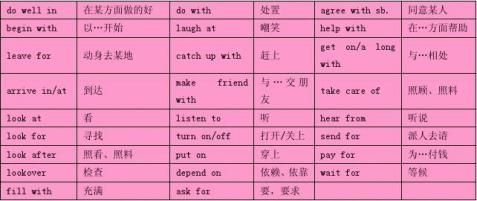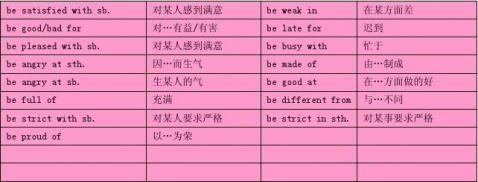初中阶段介词用法汇编
※一、表示时间的介词: 1、
“at时间点,有on必有天,in指月季年,也和色相连”
就是说,有具体的时间点的时候用at,具体那一天用on,说到月份,季节,年份,就用in ;而且说谁穿了什么颜色的衣服的时候,也是用in XX(color)】
at用于某一具体时刻或重大节日之前
①在五点钟______②在中午________③在夜晚________④在圣诞节________⑤在午夜_________
【答案】①at five o’clock ②at noon ③at night ④at Christmas ⑤at midnight
(2)on用在具体某一天或某天的上午、下午、晚上之前
①在国庆节_________②在周二晚上_________③在星期天_________
【答案】①on National Day ②on Tuesday ③on Sunday
(3)in用在周、日、季节、年或泛指的上午、下午、晚上前
①在一周内_________②在五月_________③在夏季_________④在20xx年_________⑤在下午_________
【答案】①in a week ②in may ③in summer ④in 2009 ⑤in the afternoon 归纳总结
在初中阶段常见的固定短语
in English用英语 in a minute一会儿、立刻 in a short while一会儿、不久 in a hurry匆匆忙忙 in danger在危险中 in full全部地、详细地 in a word一句话 in all总共 in every case不管怎样 in the end最后 in spite of尽管 in person亲自
in fact事实上 in good health身体健康的 in front of在??前面 in some ways在某些方面 in common共同的 in public当众
☆考题再现:---Who was the first man with A(h1n1) flu in mainland China know for sure? ---________May 11,2009.
A In B On C For D Since
【答案】B 【解析】在具体的某一天用on 2、before表示“在某时刻或某件事之前”,after用在时刻或某件事之后。
①We must leave ______.八点钟之前我们必须离开。(before 8 o’clock)
②________breakfast ,he hurried to school.早餐后,他匆忙上学去了。(After)
☆考题再现:When the school biulding began to shake,the teachers ran downstdirs _____all the students.The teachers are real hero.
A .after B .with C .befor
【答案】A 【解析】after“在??之后”,with“与??一起”,before“在??之前”。老师们是英雄,说明老师们在地震后跑在了学生之后。 3、(1)by表示“在??之前,到??为止”
You must hand in your homework ______nine o’clock.你必须在9点前交上家庭作业。(by)
(2)till与until都有“直到??”或“直到??为止”之意,till多用于口语,且不能放在句首,till和until用于肯定句时,主句中动词的动作一致延续到till或until后的时间为止;till和until用于否定句时,主句中的动词是瞬间动作,它的动作要到till或until后的时间才发生。
Eg:①He can not be back _____January.直到一月份他才回来。(till/until)
②We waited _____10 o’clock last night.昨晚我们一直等到10点钟。(till/until) 4、since, for
1
Since 和for后接时间都可用于完成时,表示某一动作“延续了一段时间”。而for后跟“时间段”,since后接时间点,常与含延续性动词的完成时连用。
(1) The Green family have been in China ________four years.格林一家在中国已经四年了。
(2) He’s been here _________ two years ago.他来这儿已经两年了。
【答案】(1)for (2)since
5、in ,after
两者都有“在一段时间之后”之意,但“in+时间段”表示时间从现在算起,常用语将来时态;而“after+时间段/时间点”表示的时间从过去算起,多用于过去式。Eg:
(1)I will finish the work _____two hours.两个小时后我将完成这项工作。
(2)He returned his hometown _________half an year.半年后他返回了他的故乡。
【答案】(1)in (2)after
【考题再现】No hurry.The bus will arrive _______ten minutes.
A .at B. for C.in D. by
【答案】C
【解析】在将来时中,in用在一段时间之前,表示在一段时间之后。故选C
6、during,through
(1)during意为“在一段时间内”的行为或状态,与一段时间的整体连用。
如:during the winter,during yesterday等,也可以喝表示延续性事件的名词连用,如:during our stay,during my visit等。一般不用在现在完成时的句子里。Eg:
①I made many good friends_______my visit to China.我在中国参观期间交了很多好朋友。
②There’s too much wind in the north ______the spring.春季北方的风很多。
【答案】(1)during (2)during
(2) through表示“从……开始到……结束的全过程”。Eg
① It’s very hot______the whole summer this year.全年整个夏季都很热。
② We work from Monday _______Sunday.从周一到周日我们都在上班。
【答案】①throgh ②throgh
※二、表示地点的介词: 表示方位的介词:in、on、to
In表示“在?内”,on表示“与?相邻”,to表示“在?之外,又不相邻”
①A is in the northeast of B.②A is on the west of B.③B is to the east of A.
【考题再现】Taiwan is a beautiful
island and it’s _____east of Fujian.
A.in B.on C.to
【解析】在表示方位时,in表在内部,on
表相邻,to表在外部,又不相邻。台湾在
附件的外部,与福建隔海相望。故选 C
2、表示“在?之上或之下”的介词
(1)on、over、above表示“在?之上”。On表示接触的上方,over表示不接触的正上方,above表示不 接触的斜上方。Eg:
① My pencil-case is _____ Li Lei’s desk.我的铅笔盒在李磊的课桌上。(on)
② There is a bridge _____ the river.河上有座桥。(over)
③ The plane is flying _____ the clouds.飞机在云层上飞行。(above)
(2)bneath、under、below都有“在?之下”之意。Beneath是on的反义词,表示接触的下方;under是over的反义词,表示不接触的正下方;below是above的反义词,表示不垂直且不与表面接触的下方。Eg:①Please do not write _____this line.请不要写在这条线的下面。(below)
2
②The boy find his lost knife _____a pile of leaves.那男孩在一堆树叶下发现了他丢失的小。
(beneath)
③The water flows _____the bridge.水在桥下流过。(under)
【考题再现】The weather report said that the temperature would fell _____(在?下面)zero.
【答案】below 【解析】“在?下面”可用below或under,表示在温度的上方或下方用above(上)或 Below(下)。
3、表示在某地的介词:at、in、on
at—表示较小的地点,in—表示较大的地方,on—表示在一个平面上。Eg:
①_____ Shanghai.②_____ home.③_____ ground.【答案】① in ②at ③ on
【考题再现】Tom told me his parents had arrived _____Beijing.
A. at B. on C. in D. to 【答案】 C
【解析】arrive后接两个介词in或at,at接小地方,in接大地方。北京是大地方,故选C。
4、表示“前、后”的介词
⑴in front of ,in the front of,before 表示“在?之前”
in front of = before表示“在某一范围之外的前面”
in the front of表示“在某一范围之内的前部” eg:
①Tom is short and always sits _____ the classroom.汤姆很矮,一直坐在教室的前面。(in the front
Of)
②There is a tree _____ my house.我的房前有棵大树。(in front of/before)
⑵at the back of,behind,after三者均有“在?之后”之意,at the back of是in the front of的反 义词,表示“在某一范围之内的后部”,behind是in front of的反义词,表示“在某一范围之外的后面”, After可与behind互换,也可以用于表示运动的词词后面。Eg:
①The couples are walking _____their son.这对夫妇跟在他们的儿子后面散步。(after)
②Your cat is hinding _____the tree.你的猫躲在树后面。(behind)
③There’s a blackboard _____the classroom.教室后面有块黑板。(at the back of)
【考题再现】There is a bank _____(在?后面)the bus station.【答案】behind
【解析】在某一物体外部的后面,用介词behind
5、表示“里外”的介词
⑴in表示“在?内”,有静止之意,inside表示“在?里面”、“到?里面”,强调“以?为界”之意, into表示动作的方向,意为“到?内”。 Eg:
①My wallet is _____the closet.我的钱包在衣柜里。(in)
②The boy rushed _____ the house.这个男孩冲进房子。(into)
③He was reading English _____the door.他在家里读英语。(inside)
【考题再现】The school days are busy enough,yet the taylors try to fit as much as possible _____their kid’s lives.
A. in B. into C. on D. at
【答案】B 【解析】fit into是固定短语。
⑵outside是inside的反义词,表示“在?外面”,out of 是into的反义词,表示“到?外”。 Eg: ①Don’t look _____the window when you are in class.上课时不要想窗外看。(out of)
②They are having an important meeting ,please wait _____ the office.他们正在召开一个重要的会 议,请在办公室外边等候。(outside)
3
※三、其他介词
1、表示材料与手段的介词:with,by,in
⑴with表示用什么工具,所用的东西都是具体的物。 Eg:
We see _____our eyes and hear _____ears.我们用眼看,用耳听。(with,with)
⑵by指“靠?手段”,“用?方法”,“凭借?动作”,所表示的方法、手段、途径比较抽象,后接名词、代 词或动名词,也可和bus、plane、bike等表示交通手段的名词连用。 Eg:
①He earns his living _____writing.他靠写作谋生。(by)
②I shall contact you _____telephone.我将打电话和你联系。(by)
③I will travel to Hainan ______ air.我将乘飞机去海南。(by)
【考题再现】Lin Lin often practices English _____chatting with her American friend.
A. in B. by C. for D.with
【答案】B 【解析】by后接动名词常表示使用某种方法或通过某种途径。
⑶in表示“所用材料以及所用的语言、声音、衣饰等” eg:
①They are talking _____Japanese.他们正用日语交谈。(in)
②The boy always _____a blue heat.男孩常带一顶蓝帽。(in)
③I like to draw picture _____red ink.我喜欢用红墨水画画。(in)
【考题再现】Betly let’s make a cake _____some flour,sugar,butter and milk.
A. at B. of C. in D. with
【答案】D 【解析】根据句意“Betly让我们用面粉、糖、黄油、牛奶做面包”可知,空格部分介词为用, With指工具或材料,故选D。
2、of,from,about
Of表示“属于?的”,表示数量或种类;from表示“是哪里人”以及时间或时间的起点来自;about“关于?”、 “大约、左右”等。 Eg:
①The old man sit here _____morning.从早晨起老人就坐在这儿。(from)
②Wang Hong is a friend _____mine.王红是我的一位朋友。(of)
③I know nothing _____him.我对他一无所知。(about)
④There are _____fifty people in the room.房间里大约有50人。(about)
⑤Here is a cup _____tea for you.给你一杯茶。(of)
⑥These visitors are all _____American.这些游客都来自美国。(from)
【考题再现】I got an e-mail this morning.It was _____ my foreign friend ,Tony.
【答案】D 【解析】be from意为“来自”,表明主语的出处。
※四、几个已混介词的用法辨析
1、between,among
between指“两者之间”包括两个以上的人或物中两两之间。among指三者或三者以上的中间。 Eg: ①My school is _____the post office and the hospital.我的学校在邮局和医院之间。(between) ②I found him _____the crowd.我从人群中发现了他。(among)
【考题再现】You must ride your bike _____the right side of road.
A. at B. on C. in D.for 【答案】B 【解析】在左/右要用介词on
2、across,through
4
Across的含义与on有关,表示某一动作在某一物体的表面进行,其意思为“横过”,用来表示出于或到达 一条线、一条河或一条道路的另一侧。through的含义与in有关,表示动作发生在立体空间,是从内部穿 过。常用来表示穿过洞形、筒形或类似的封闭物体到达另一端。 Eg: ①He walked _____the forest.他穿过了森林。(through) ②We walked _____the road.我们横穿马路。(across)
【考题再现】Let’s go _____the road.The shop is _____the other side. A.across,on B.cross,on C.through,in D.between,on
【答案】A 【解析】across与cross表示横穿,常用来穿街道、马路等;through表示从内部穿过,常用来穿森林、隧道等。
3、beside,except,but
三词都有“除?之外”之意,但beside表“除?之外,还有?”,指整体中加入一部分,含义是肯定的; Except和but都表示从整体中除去部分,常可换用,但but着重在整体,常用在on,all,nobody,where, Who等词后,except不受此限,且着重在除去的部分。 Eg:
①I’m free every day______today.除了今天我每天都有空。(except)
②There’re many rivers in China _____the Changjiang and Huanghue.中国除了长江和黄河外还有许
多河流。(beside)
③Who ______ Steve would do such a thing.除了史蒂芬谁还会干这种事。(but)
【考题再现】Mr. Lin gave the textbook to all the students_____the ones who had already taken Them. A. except B.including C.among D.with 【答案】A 【解析】except表示“排除在外”,即把其后的宾语排除在发生的范围之外。
※五、含有介词的固定搭配
1、介词与动词

【考题再现】——What would you do _____the lost libarary book? ——I would by to find it or pay _____ it.
A.for,to B.about,for C.with,for D.with,to
【答案】C 【解析】本题考查的是介词的固定搭配。do with意为“处置”、“对付”,pay for“为?付钱”
2、介词和形容词的固定搭配
5

【考题再现】We must be strict _____ourselves and strict_____our work. A.in,with B.with,in C.in,in D.with,with 【答案】B
【解析】本体考察的是介词和形容词搭配的固定短语。be strict with sb.意为“对某人要求严格”,对 某事要求严格在strict后面接in
3、介词与名词搭配
6

